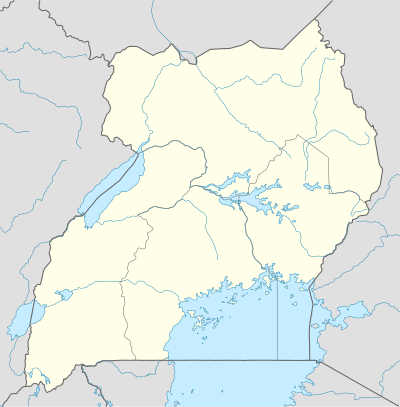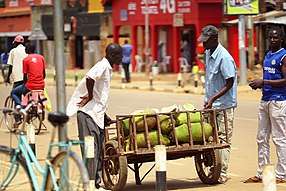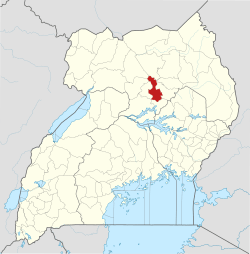Lira, Uganda
Lira is a city in the Northern Region of Uganda. It is the main municipal, administrative, and commercial centre of Lira District.[3]
Lira | |
|---|---|
 Lira Location in Uganda | |
| Coordinates: 02°14′50″N 32°54′00″E | |
| Country | |
| Region | Northern Region of Uganda |
| Sub-region | Lango sub-region |
| District | Lira District |
| Founded | 1919 |
| Town Council | 1962 |
| Municipality | 1985 |
| City | 2021 (Expected) |
| Government | |
| • Mayor | Mike Ogwang Olwa Veve[1] |
| Elevation | 3,488 ft (1,063 m) |
| Population (2014 Census) | |
| • Total | 99,059[2] |
History
Lira was one of the last towns in Uganda held by loyalists of Idi Amin during the Uganda–Tanzania War (1978–1979). A force consisting of the Tanzania People's Defence Force's 201st Brigade and the Uganda National Liberation Front's Kikosi Maalum attacked Lira on 15 May 1979, ousting the Amin loyalists after a short battle. The clash at Lira was the last important battle of the Uganda–Tanzania War, as the remnants of Amin's army completely disintegrated thereafter.[4]
Location
Lira is approximately 101 kilometres (63 mi), by road, southeast of Gulu, the largest city in the Northern Region of Uganda, along the highway between Gulu and Mbale.[5] This is approximately 342 kilometres (213 mi), by road, north of the city of Kampala, the capital and largest city in that country.[6] Lira is approximately 125 kilometres (78 mi) northwest of Soroti, the nearest large town to the south.[7] The coordinates of Lira are 2°14'50.0"N 32°54'00.0"E (Latitude:02.2472; Longitude:32.9000).[8] The city lies at an average elevation of 1,063 metres (3,488 ft), above sea level.[9]
Population
The 2002 national census estimated the population of Lira at 80,900. In 2010, the Uganda Bureau of Statistics (UBOS) estimated the population at 105,100. In 2011, UBOS estimated the mid-year population at 108,600.[10] In August 2014, the national population census put the population at 99,059.[2]

Transport
Lira is served by a railway station of the Uganda Railways network.[11] The city is also served by a public civilian airport, Lira Airport, administered by the Civil Aviation Authority of Uganda.
Power line
An 80 kilometres (50 mi) 132 kilovolt electricity line from the Karuma Power Station is under construction to a substation in Lira, under the supervision of Intec Gopa International Energy Consultants GmbH of Germany.[12]
Points of interest
The following additional points of interest lie within the town limits or close to the edges of the city:
- Offices of Lira Municipal Council
- Lira Main Market
- Ngetta Rock
- Lira University, a public university in Uganda
- Lira Campus of Uganda Martyrs University, a private university, whose main campus is located in Nkozi, Mpigi District
- All Saints University, a private university affiliated with the Church of Uganda
- A branch of the National Social Security Fund
- Ministry of Water and Environment Upper Nile region branch
- Lira Integrated School, a mixed, residential, nursery, primary and secondary school.[13]
- Secondary Schools include he following public schools: Lango College, Comboni College, Dr. Obote College, St. Katherine Girls School.
- Lira Town College, a secondary school.[14]
Notable people
- Sam Engola, politician and businessman
- Dusman Sabuni, military officer and rebel leader
See also
References
- Denis Ogwal (July 20, 2017). "Lira Municipal Development Forum Elects New Executive". New Vision. Retrieved June 9, 2018.
...among the development programs that the committee is mandated to monitor is the implementation of Uganda Support Municipal Infrastructural Development (USMID) program.
- UBOS (27 August 2014). "The Population of The Regions of the Republic of Uganda And All Cities And Towns of More Than 15,000 Inhabitants". Citypopulation.de Quoting Uganda Bureau of Statistics (UBOS). Retrieved 21 February 2015.
- Draku, Franklin (22 May 2019). "Cabinet Elevates 15 Municipalities To Cities". Daily Monitor. Kampala. Retrieved 23 May 2019.
- Cooper & Fontanellaz 2015, pp. 37, 39.
- Globefeed.com (2 November 2019). "Distance Between Gulu, Uganda And Lira, Uganda". Globefeed.com. Retrieved 2 November 2019.
- Globefeed.com (2 November 2019). "Distance Between Posta Uganda, Kampala City Centre, Kampala, Uganda And Posta Uganda, Agwata-Lira, Ireda, Lira, Uganda". Globefeed.com. Retrieved 2 November 2019.
- Globefeed.com (2 November 2019). "Distance Between Lira, Uganda And Soroti, Uganda". Globefeed.com. Retrieved 2 November 2019.
- Google (2 November 2019). "Location of Lira At Google Maps" (Map). Google Maps. Google. Retrieved 2 November 2019.
- Floodmap.net (2018). "Elevation of Lira, Uganda". Floodmap.net. Retrieved 2 November 2019.
- UBOS. "Estimated Population of Lira In 2002, 2010 And 2011" (PDF). Uganda Bureau of Statistics (UBOS). Archived from the original (PDF) on 7 July 2014. Retrieved 3 June 2014.
- Cissy Makumbi, Cissy (28 October 2013). "Museveni Opens Gulu Railway Line". Daily Monitor. Retrieved 3 June 2014.
- Odyek, John (13 August 2015). "UETCL Signs €5.2 Million (USh20.5 Billion) Deal With German Company". New Vision. Kampala. Retrieved 13 August 2015.
- Schlein, Lisa (14 December 2014). "Ugandan Entrepreneur Creates Education Opportunity for Girls". Washington, DC: Voice of America. Retrieved 23 May 2019.
- Angoda Emmanuel. "School Report Cards System: What Works In Lira Town College & Northern Uganda". Lira, Uganda: AngodaEmma.Wordpress.com. Retrieved 23 May 2019.
Works cited
- Cooper, Tom; Fontanellaz, Adrien (2015). Wars and Insurgencies of Uganda 1971–1994. Solihull: Helion & Company Limited. ISBN 978-1-910294-55-0.CS1 maint: ref=harv (link)
